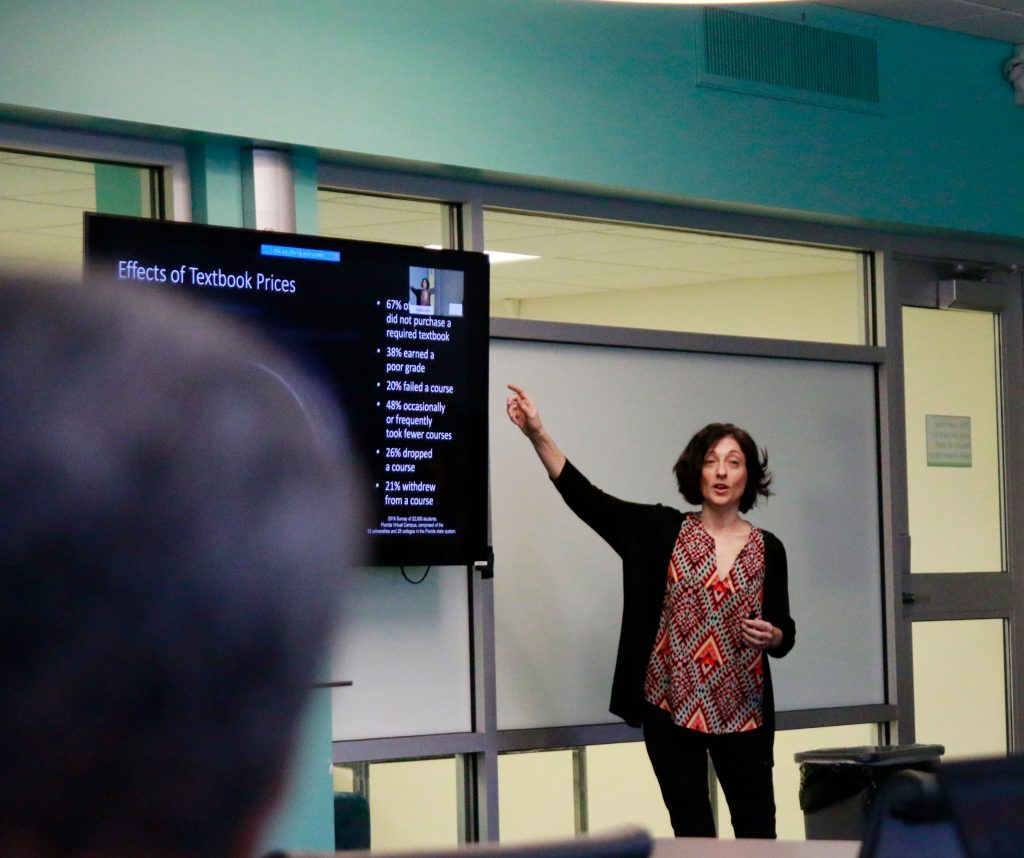
In Florida Virtual Campus’ 2016 Student Textbook and Course Materials Survey, 56.3 percent of 22,000 student respondents said they pay more than $300 for textbooks per semester. Forty-five percent of students surveyed said they hadn’t signed up for a course because the required textbooks were too expensive.
Robin DeRosa, professor and director of interdisciplinary studies at Plymouth State University in New Hampshire, said the implications of statistics like these are what she’s trying to combat with the help of open educational resources.
On Friday, Nov. 30, DeRosa spoke to Binghamton University faculty, staff and librarians in LN-1302C, also known as the Zurack Family High-Technology Collaboration Center, about the benefits of open educational resources, an initiative that makes course materials a part of the public domain, ensuring that students can access them at no cost.
According to DeRosa, she first experimented with open-access materials when she enlisted a few of her students to create an anthology of American literature for one of her classes.
“I realized that my students were paying $90 every semester for public domain literature about their own American heritage,” DeRosa said. “I thought, ‘This is either the least American thing on the planet or the most American thing on the planet that we’re charging students all this money for public domain literature.’”
DeRosa soon became an advocate for open educational resources. She emphasized that the initiative doesn’t stop at making sure students can afford course materials, but is meant to maintain a sustainable ecosystem so that students can finish their education. For DeRosa, this meant implementing small changes within her department, such as providing a child care co-op for students with kids, setting up a food pantry in her office and implementing a department ride-share board for emergencies if students needed to get to campus.
“I started thinking more about this survive domain,” DeRosa said. “Could students come in to get this content delivery … if, for example, they didn’t have the gas money to put in their car to come to class?”
Mark McBride, library senior strategist for the Office of Library and Information Services at the SUNY system administration, helped connect BU with DeRosa. He said SUNY is currently working to encourage the usage of open educational resources at SUNY schools.
“At the system level, we’re very interested in student affordability, and so we’re looking at [open educational resources] as a pathway to help with that affordability,” McBride said. “Now our faculty is beginning to tell us different stories, so it’s not just an affordability equation. It’s a lot of what Robin discussed today ― it’s about student success.”
According to the SUNY Open Educational Resources Services website, SUNY received $4 million from the state to fund the implementation of open educational resources. Currently, 27 SUNY campuses are engaged with open educational resources at some level.
Critics of open educational resources have expressed concern for professors, who wouldn’t receive royalties from content they’ve published if open access becomes a reality at BU. But according to McBride, many faculty do not receive many royalties from their published work, so most professors would not be significantly affected if they began using open educational resources.
Cláudia Marques, an assistant professor of biological sciences at BU, said she plans to start using open education resources in her curriculum next semester to help her students. After listening to DeRosa speak, she said she thought it would be an easier task to complete than she originally believed.
“It’s more straightforward than I thought,” Marques said. “[It’s important] particularly because a lot of students can’t afford books and it’s easier for them to be able to download an open source for free.”


